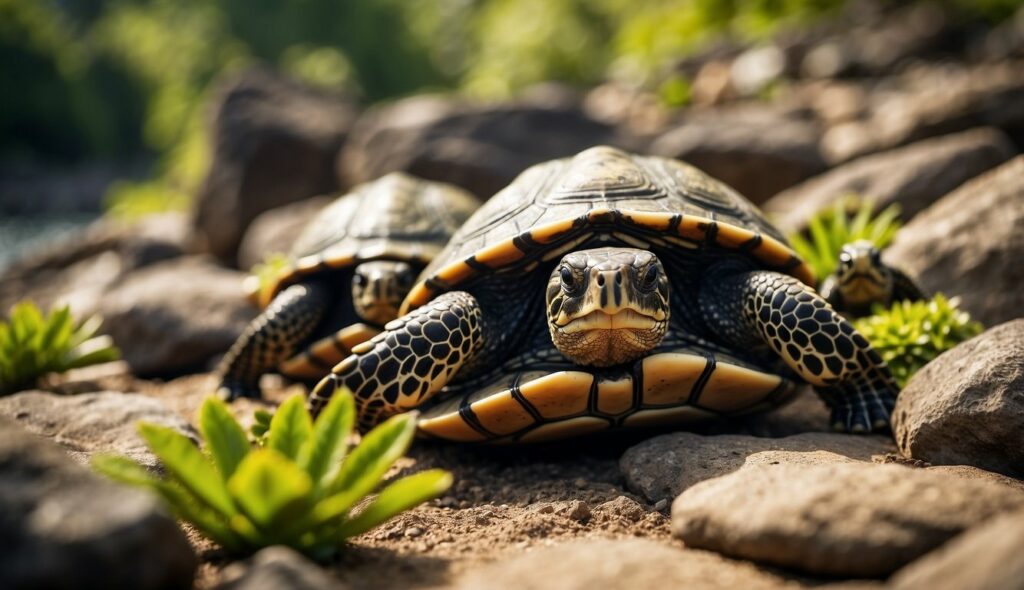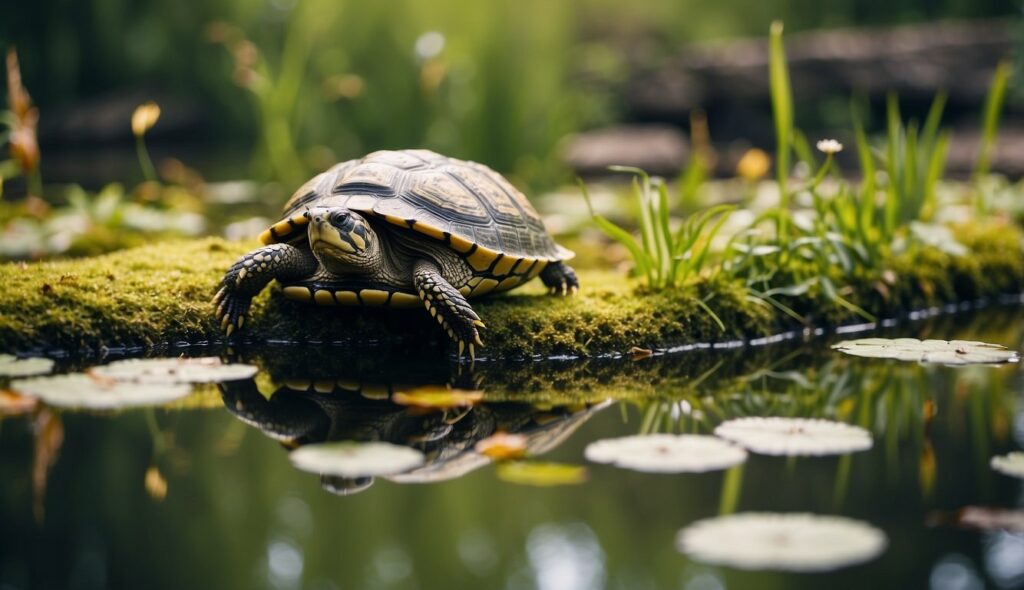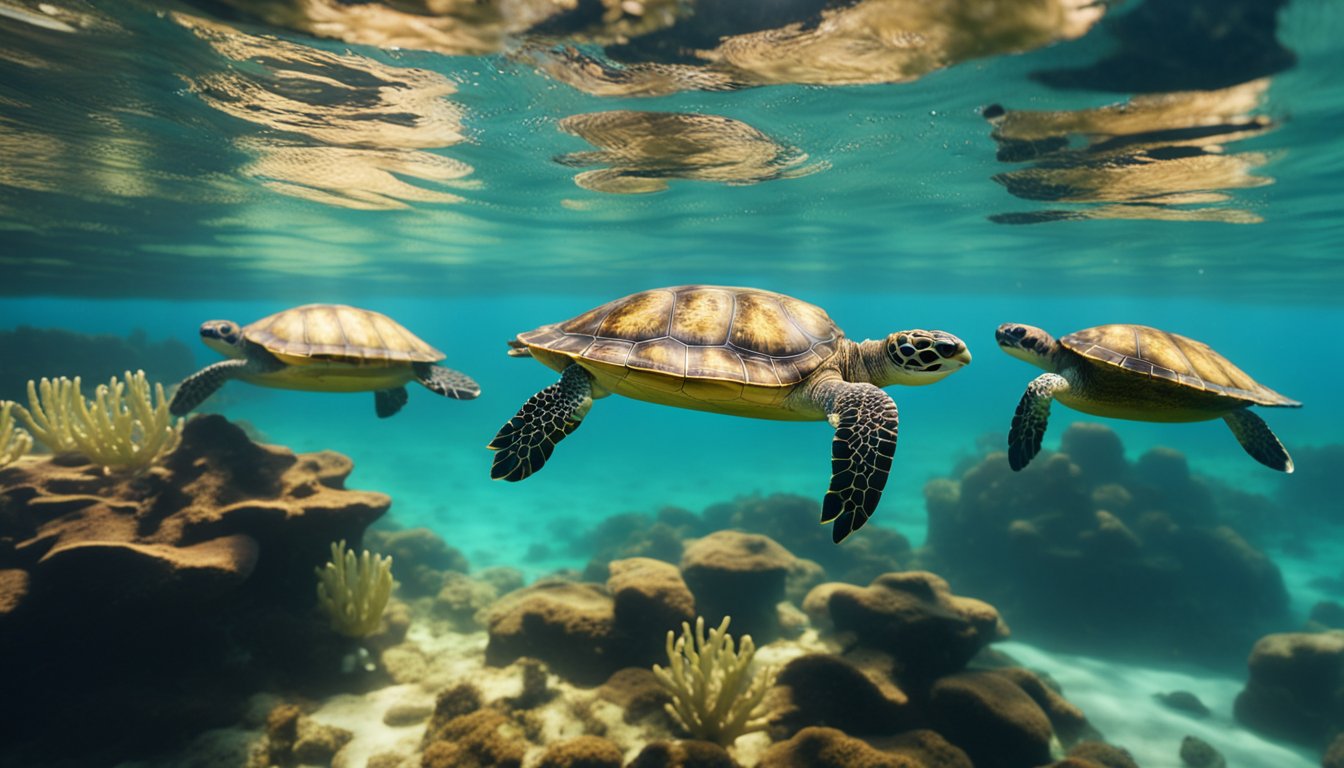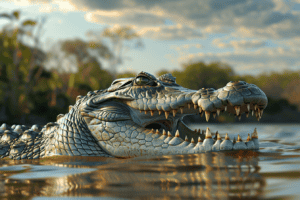Turtles are extraordinary creatures that carry their homes on their backs and have been wandering the Earth for millions of years—way before dinosaurs roamed.
Imagine being able to retreat into your shell whenever you felt like it, peeking out just like a turtle does.
These shelled wanderers lead fascinating lives in water and on land.
With their slow but steady pace, they teach us the power of patience and the art of taking one step at a time.

Did you know that some turtles are travelers, and others are stay-at-homes?
Sea turtles can glide across vast oceans, gracefully tumbling in currents like leaves in the wind.
Yet some of their cousins, like the box turtle, may spend their whole life in an area smaller than a soccer field.
Think about it: one cousin exploring the deep blue, while the other knows every nook and cranny of its own backyard.
As young explorers, one might wonder what turtles snack on. These creatures aren’t picky eaters!
Depending on the species, some turtles enjoy munching on jellyfish, while others happily gobble up fruits and flowers.
They even have a built-in cleanup crew in the form of tiny organisms that live on their shells.
These little helpers ensure that a turtle’s shell stays nice and tidy by eating away the algae and debris.
Imagine having a team of mini cleaners on you, isn’t that cool?
Where Do Turtles Live?

The world is a big, wonderful place, and it’s also the home of turtles who have spread their flippers and shells across a vast array of habitats.
From the salty waves of the oceans to the tranquil waters of freshwater havens, let’s wade into the world where turtles feel right at home!
Oceans and Beaches
In the vast blue oceans, sea turtles glide gracefully under the waves, with most of their life spent far from shore.
They venture through warm and temperate seas, often migrating long distances between their feeding grounds and the beaches where they hatch.
A special mention is for the nesting sites, such as beaches with soft sand, where mother turtles make their way ashore under the cover of night to lay their precious eggs.
Shallower coastal areas with seagrass beds are like underwater cafés for turtles, offering plentiful dining on seagrasses and algae.
Freshwater Retreats
Not all turtles crave the salty sea; many prefer the serene settings of freshwater habitats.
These turtles find their homes in rivers, lakes, ponds, and even swamps.
One might spot them basking on a log in a calm river or tucked away in the reedy fringes of a marsh.
Freshwater turtles show remarkable adaptability, with some species enduring seasonal variations by burrowing into the mud to hibernate through cold weather.
They’re true survival artists, painting a picture of patience as they wait for the warmth to return.
Anatomy of a Turtle

Exploring the anatomy of a turtle reveals a fascinating and complex design tailored for survival.
They have unique features like their hard protective shells and specialized limbs that show the wonders of adaptation.
1. Protective Shells
The turtle’s shell is not just a home they carry on their back; it’s a superpower in the reptile world.
It’s made up of two parts: the top part is called the carapace, and the bottom part is known as the plastron.
These two parts are connected by a bony bridge, making the shell one solid piece of armor.
The shells are made of about 60 different bones covered in plates called scutes, which are made of keratin, the same stuff in your fingernails.
Imagine wearing a shield all day, every day — that’s what it’s like to be a turtle!
2. Flipper and Claw Features
Depending on their habitat, turtles have limbs designed for swimming or digging. Sea turtles have flippers that make them master swimmers in the ocean.
These flippers power through the water, allowing them to glide gracefully and with great speed.
On the flip side, land-dwellers like the box turtle have sturdy claws for digging and maneuvering on rough terrain.
They may not win a sprint, but they are fantastic diggers, creating burrows for homes or to find food.
Isn’t it amazing how turtles’ limbs are perfectly suited to their environment?
Lifespan and Growth

Turtles are fascinating creatures, especially when we look at how long they can live and how they grow.
These shell-bound friends of ours have a journey from the moment they peek out of their eggs to the time they become ancient wanderers of the waters and lands.
From Hatchling to Adult
When a turtle hatches from its egg, it’s tiny, vulnerable, and has an incredible journey ahead.
The hatchling, often no bigger than a coin, must make a treacherous trek to the water, evading predators at every turn.
As they reach safety and commence their lives, they grow slowly but steadily.
For example, the green sea turtle can take anywhere from 20 to 50 years to reach full maturity and can grow from an initial tiny size of approximately 2 inches (5 cm) to an awesome 5 feet (1.5 meters) in length.
The Old Timers of the Animal Kingdom
Turtles are renowned for their impressively long lifespans.
Some species are known to live for over a century, making them some of the oldest living animals on our planet.
These wise old creatures, like the majestic giant tortoises, can live to be over 100 years old with the oldest recorded tortoise reaching the ripe age of 188 years.
The secret to their long lives may lie in their slow metabolism and their ability to go for long periods without food or water, a fascinating aspect of their biology that has intrigued scientists and animal lovers alike.
What Do Turtles Eat?

Turtles have varied diets that depend on their species and habitat. They can be vegetarians, carnivores, or omnivores.
Now let’s explore what different types of turtles munch on!
Vegetation Grazers
Many turtles are herbivores, meaning they love to eat plants.
They might be spotted leisurely nibbling on algae or sea grasses, which are like the underwater equivalent of a field of green.
These gentle grazers play a crucial role in their ecosystems by maintaining healthy levels of vegetation.
The green sea turtle, with its serrated jaw, is perfectly adapted to feast on a variety of sea grasses and algae.
Fun fact: did you know that the color of their body fat can turn green because of their diet?
Turtles Are Meat Lovers
On the flip side, some turtles are carnivorous, especially during their younger years when protein is essential for growth.
These meat lovers dine on anything from small insects and fish to sometimes more slippery fare like jellyfish!
The snapping turtle, for instance, has a powerful beak that can easily snatch a meal.
They lie in wait, buried in the mud, and then snap—dinner is served!
The leatherback sea turtle, the largest of all sea turtles, mainly feasts on jellyfish and can consume up to twice its body weight in this gelatinous delicacy.
Frequently Asked Questions
What incredible abilities do turtles have that help them survive in the wild?
Turtles are equipped with a suite of survival skills. They have sturdy, retractable legs and can tuck themselves into their shells for protection.
Aquatic turtles possess webbed feet for swimming, while some species can even hibernate during cold months, lowering their metabolism to survive.
Can you tell me about the different kinds of homes turtles live in across the world?
Turtles are found in a variety of habitats.
Sea turtles roam the warm oceans, gliding gracefully through the waters, whereas freshwater turtles inhabit lakes and rivers with soft, muddy bottoms.
Land-dwelling turtles, like tortoises, favor dry, sandy environments where they can dig burrows to escape the heat.
Why do some turtles have hard shells and others have soft ones, and how does that help them?
A turtle’s shell serves as its shield. The hard shells of many turtles are made of bony plates called scutes, which protect them from predators.
Soft-shelled turtles, on the other hand, rely on their agility in water and muddy hiding places to stay safe, as their softer shell provides less protection but more speed.
How do turtles manage to live both on land and in water, and what adaptations do they have for this lifestyle?
Turtles that live both on land and in water, called semi-aquatic turtles, have adapted to their environments in fascinating ways.
Their streamlined shells help them in swimming, and their limb adaptations allow them to walk on land.
Lungs that can extract oxygen from the water and the air assist them in breathing, no matter where they are.
What do turtles like to eat, and how does their diet change as they grow?
A turtle’s diet is as varied as its habitat.
Young turtles tend to be carnivorous, hunting for meaty food to grow, while adults often shift to an omnivorous diet, including plants.
Sea turtles feast on jellyfish and algae, whereas some land turtles enjoy fruits and leafy greens.
How can we, as young explorers, help protect turtles and their habitats?
Protecting turtles entails preserving their natural habitats and keeping oceans clean.
They face threats from pollution and habitat destruction, so participating in beach clean-ups and advocating for marine sanctuaries are significant steps toward their conservation.
Every action taken to protect the environment helps ensure turtles have a safe home.









